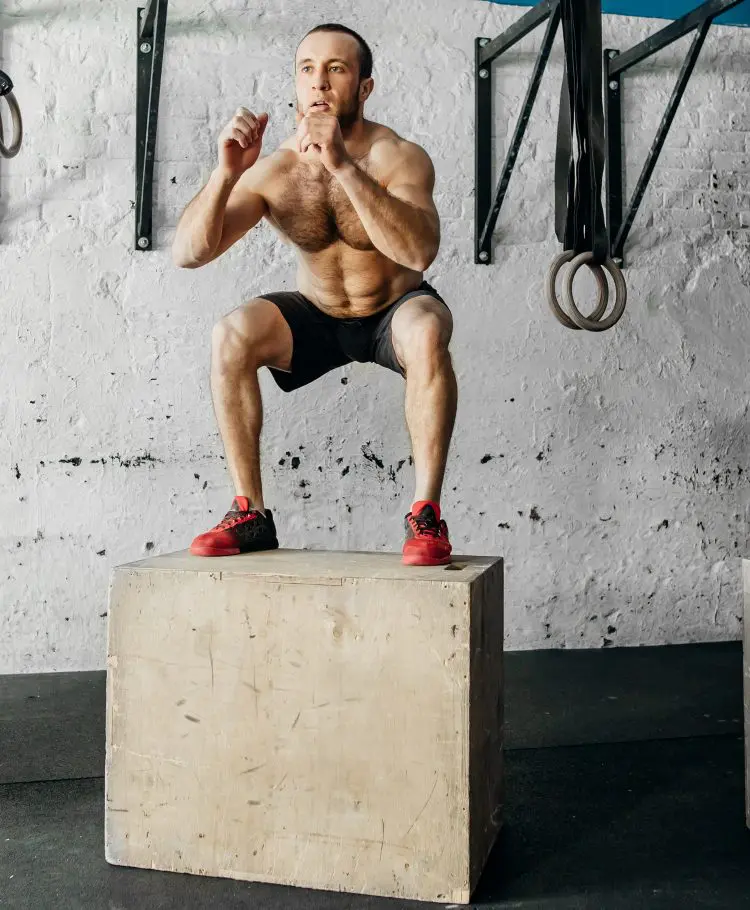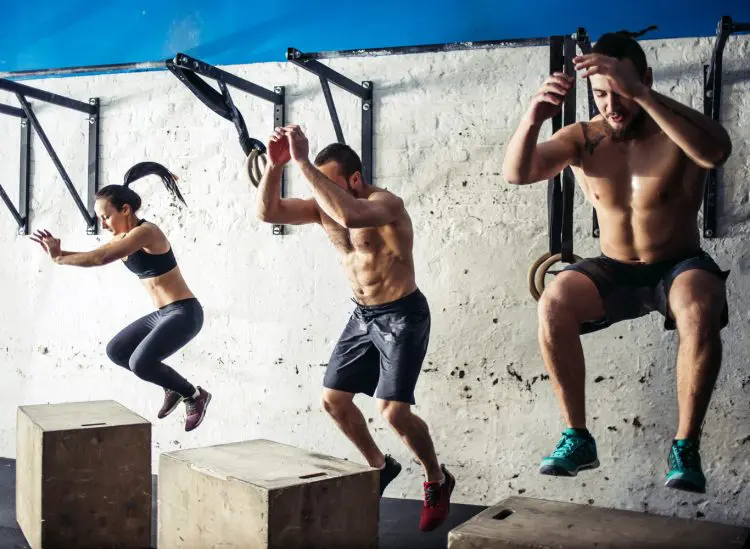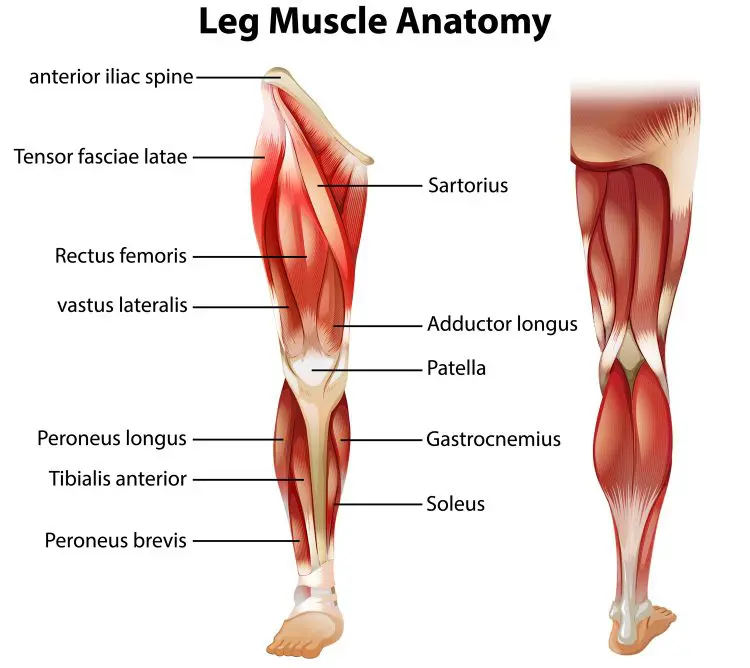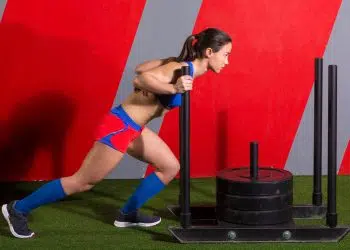Plyometric or jump training is one of the best ways to develop muscle power. Muscle power is your ability to generate force quickly. Examples of muscle power include jumping, sprinting, kicking, punching, and throwing. Most sports involve muscle power, and athletes from all sports use power exercises in their training.
A lot of exercisers turn to the Olympic lifts to develop power. However, the clean and jerk and snatch can be time-consuming to learn and are hard to master. Plus, to do them properly, you need shock-absorbing bumper plates and a weightlifting platform, not to mention a high-quality Olympic barbell.
Thankfully, there are power exercises that aren’t Olympic lifts. These exercises are generally easier to learn, require little or no specialist equipment, and are often safer too.
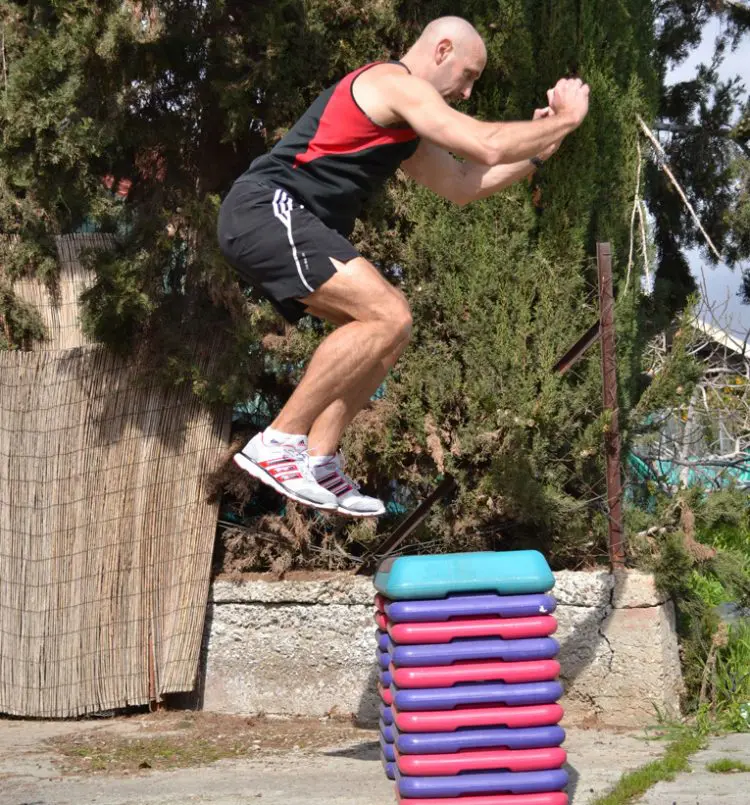
One of the most accessible, safe, and effective alternatives to the Olympic lifts is the box jump. In this guide, we’re going to explain why and how to do this exercise and provide you with a few variations and alternatives that you can use to keep your workouts interesting and productive.
What is Plyometric Training?
Before we get into the nuts and bolts of box jumps, it’s worth spending a moment defining plyometric training. After all, box jumps are a plyometric exercise.
Level Up Your Fitness: Join our 💪 strong community in Fitness Volt Newsletter. Get daily inspiration, expert-backed workouts, nutrition tips, the latest in strength sports, and the support you need to reach your goals. Subscribe for free!
Plyometric training involves a rapid loading and unloading of your muscles. This triggers something called the stretch reflex, which allows your muscles to generate more force than usual. In simple terms, it turns your muscles into springs. Plyometric training enhances this reflex so you can generate more power at will, increasing muscle activation (1).
Plyometric exercises are best done for low reps and with maximal effort. That’s the best way to develop muscle power. However, box jumps can also be done for higher reps. While this won’t do much for muscle power, it will enhance muscular endurance and makes for a challenging conditioning exercise.
As beneficial and popular as plyometric training is, it is not without risks. The main issue is the impact of landing from a jump. The good news is that, with box jumps, you land on a raised platform, which significantly reduces impact and injury potential.
If you are looking for a safe but effective lower-body plyometric exercise, box jumps could be one of the best choices.
How to Perform Box Jumps
Box jumps are one of the safest plyometric exercises around. That said, it’s still possible to do them incorrectly. Poorly performed box jumps will produce less than optimal results and could also lead to injury.
- Set up your box. It should be sturdy, stable, and won’t tip over. Start off with a box that’s about knee-height or a little lower.
- Stand about one large step back from your box. Your feet should be around shoulder-width apart. Hold your arms down by your sides.
- Descend into a quarter-depth squat and swing your arms behind you.
- Without pausing, explosively drive your feet into the floor, swing your arms forward for extra momentum, and jump up and onto your box. Jump as high as you can.
- Land lightly on the top of your box, aiming your feet for the middle. Bend your legs to absorb the shock of your landing.
- Step back down, reset your starting position, and repeat.
While you CAN jump down instead of stepping down, doing so significantly increases impact and joint stress, negating one of the biggest benefits of this exercise. Stepping down is much better for your joints but, if you are using a reasonably low box and are doing box jumps for conditioning instead of power, jumping down may be acceptable.
Note: If you do this popular exercise, make sure you do it right!
The Benefits of Box Jumps
Done correctly, box jumps are a very beneficial and effective exercise. Reasons to add this movement to your workouts include:
Jump higher – if you want to increase your vertical leap, maybe for basketball, box jumps can help. With training, this exercise should add inches to your vert. While we can’t promise you’ll become king of the dunk, you’ll definitely get closer to the rim.
Sprint faster – sprinting involves a whole lot of hip, knee, and ankle extension, just like box jumps. Improving your box jump performance should lead to faster sprinting speeds.
Increased muscle strength and bone mass – box jumps are a safe and effective way to strengthen both bones and muscles, even in seniors (2). That’s good news if you prefer to avoid traditional lower body exercises like squats, leg presses, and deadlifts.
Fat loss – high rep box jumps are a very challenging conditioning exercise. A set of 12-20 reps will drive your heart and breathing rate sky-high, producing lots of lactic acid. Done alone as an interval training exercise or as part of a circuit, box jumps can help you achieve your body composition goals.
A better squat – box jumps increase power, speed, and explosiveness. These attributes can help you squat better. With more power, you’ll be better able to drive up and out of the bottom of your reps, using speed and momentum to get through your sticking points. This should translate to a bigger squat. The effect on your deadlift should be similar.
Less joint stress than most other plyometric exercises – with much less impact on landing, box jumps are safer than depth jumps, hurdle jumps, and regular squat jumps. This means they’re suitable for exercisers of all ages and abilities, even those with a history of joint or lower back pain.
Easy to do – unlike many power exercises, box jumps are very straightforward. All you need is a suitable platform to jump on to. Most gyms have plyometric boxes to use, and you can also do box jumps using aerobic steps.
Alternatively, you can jump up steps/stairs at home, or even onto a bench in the park. Just make sure that, whatever you are using, it won’t collapse under your weight or tip over when you land on it.
Common Mistakes to Avoid
Get the most from box jumps by avoiding these common mistakes:
Standing too far from your box – box jumps are a vertical jumping exercise and not a horizontal one. Take just one step back from your box to ensure you are jumping upward more than forward. If you want to increase your horizontal jumping prowess, you should do more broad jumps and hops.
Using too high a box – if you have to tuck your knees up to your chest to land on your box, it’s too high. You should land in a semi-squat position, and not with your knees touching your chin! Such high box jumps might make for a good YouTube video, but they are no more effective than correctly performed jumps, and the risk of injury is much higher.
Not using your arms – box jumps ARE mainly a lower body exercise, but your upper body also plays a part. Make sure you start your jump with a powerful forward arm swing. This added momentum will increase jump height. Try jumping with your arms pinned to your sides to see just how vital your arms are during this exercise!
Not fully extending your ankles, knees, and hips – to perform the perfect box jump, you should drive your feet into the floor and extend your ankles, knees, and hips more or less fully. Some exercisers are “box shy” and cut their range of motion short in an effort to pull their knees up too soon, often because they’re using a box that’s too high. If your body is not close to being straight mid-jump, you could be undermining your box jump performance.
Not matching your box height and reps to your training goal – there is more to box jumps than just leaping on and stepping off any nearby platform. Your box height and reps should match your training goal.
To develop power, use a high box and do sets of 3-5 reps. Rest 2-3 minutes between sets and focus on jumping as high as you can each rep. Stop your set/workout if you notice your jump height starting to decrease. Focus on quality and not quantity.
Level Up Your Fitness: Join our 💪 strong community in Fitness Volt Newsletter. Get daily inspiration, expert-backed workouts, nutrition tips, the latest in strength sports, and the support you need to reach your goals. Subscribe for free!
For endurance, fitness, and fat burning, use a lower box and do sets of 12-20 reps. Rest 30-90 seconds between sets to keep your heart rate up. Your jump height will probably decrease as you get tired.
Important Box Jump Tips
Get the most from this exercise with these handy tips!
Start low: Until you have a better idea of your jumping ability, use a low to moderate-height box, say 12-20 inches. Nothing ruins a box jump workout like failing to land on top of your box. At best, it’s embarrassing but could also lead to injury. Make sure you can comfortably outjump your box.
Land light: Do your utmost to absorb the shock of landing to keep the stress off your joints. Bend your knees and use them like springs. Step back down and then repeat, rather than jumping down to reduce the impact and stress even more.
Don’t pause mid-rep: To make the most of the stretch reflex, you should descend quickly to stretch your muscles and then explode upward. There should be no mid-rep pause. Try to keep the transition between the eccentric and the concentric phase of this exercise as short as possible.
Keep your hips above your knees: This tip applies to both your take-off and landing. A deep squat at the start robs you of power, while bending your hips too much on landing increases stress on your lower back. If your hips are below your knees on landing, your box is too high.
Brace your core: Keep your spine stable by bracing your core. Box jumps ARE a lower body exercise, but that force generated by your legs is driven up through your entire body and spine. Bracing your core will a) reduce your risk of injury and b) ensure that no energy is lost by stopping your midsection from collapsing.
To brace, pull up your pelvic floor like you are trying to stop the flow of urine, tense your abs like you’re getting ready to be punched in the stomach, and inhale down into your belly. Your entire midsection should feel stable and strong. Breathe between reps to ensure you can brace effectively while jumping.
Muscles Worked
Box jumps work your entire lower body. They’re a compound exercise, which means they involve two or more joints and several muscles working together. Box jumps are a very functional exercise, which means they closely replicate natural human movement.
When you do box jumps, you extend your ankles, knees, and hips all at the same time. This movement is very common and is something you do when you walk, run, or jump. Because of this, box jumps can have a significant impact on your physical performance both in and out of the gym. If you want to squat more weight, jump higher, or run faster, box jumps can help.
The main muscles worked during box jumps are:
- Quadriceps – the collective name for rectus femoris, vastus lateralis, vastus medialis, and vastus intermedius. These four muscles work together to extend your knees. Rectus femoris also flexes your hip.
- Gastrocnemius and soleus – also known as the triceps surae, these two muscles make up your calf. The gastrocnemius is your upper, larger calf muscle, while the soleus is the lower, smaller muscle. They are responsible for extending your ankle joint, and gastrocnemius also helps to flex your knee.
- Hamstrings – the collective name for the biceps femoris, semimembranosus, and semitendinosus, these three muscles flex your knee and extend your hip.
- Gluteus maximum – the glutes is the largest muscle in the human body. Located on the back of your hip, its main job is hip extension.
- Abductors – located on the outside of your hip and thigh and consisting of your gluteus medius and minimus, and tensor fascia latae (TFL), these muscles draw your thigh out and away from the midline of your body. In box jumps, they help stabilize your hips and stop your knees from falling inward.
- Adductors – adductor longus, brevis, and magnus are located on the inside of your thigh. They draw your thigh in toward the midline of your body. During box jumps, the adductors help stabilize your hips and stop your knees from falling outward.
- Core – the collective term for the muscles that make up your midsection. During box jumps, this group of muscles helps stabilize your spine so that it does not collapse as you drive off the ground or land on your box top. The main core muscles are the rectus abdominis, obliques, transversus abdominus, pelvic floor, and diaphragm.
Box Jump Variations and Alternatives
Box jumps are a SUPERB exercise for increasing power, and they can also be used for fitness and fat loss. That said, they’ll soon get old if that’s all you ever do. Here are some variations and alternatives to box jumps that you can use to avoid workout boredom and stagnation.
1. Box hops
Box hops are similar to box jumps, but you’ll be using just one leg at a time. This increases both the overload on your muscles and the balance demand of the exercise. Needless to say, this variation is quite a step up from regular box jumps, so start off with a low platform.
2. Seated box jumps
This variation starts from a stationary seated position. Starting from seated makes this exercise much harder. It teaches you to jump without the benefit of the rapid pre-stretch usually associated with plyometrics. You probably won’t be able to jump as high from a stationary start, so use a lower platform.
3. Depth box jumps
With depth box jumps, you start each rep from a raised platform. This increases the amount of resistance you have to overcome before transitioning into your jump, overloading your muscles and making the exercise more productive and effective.
On the downside, there is a lot more impact to deal with, so this variation is harder on your joints. Begin with a low starting platform; increase gradually to avoid overloading your joints.
4. CAT squats
CAT stands for Compensatory Acceleration Training and is a way to do plyometric training without actually jumping. To do CAT squats, descend as normal but then explode up out of the hole as fast as you can.
Use about 50% of your 1RM and just 3-5 reps per set. Ensure you brace your core between reps; any loss of core stability could lead to lumbar spine injuries.
5. Deepwater squat jumps
The most significant disadvantage of almost any jumping exercise is the impact on landing. That impact can equal several times your bodyweight. That’s a lot of stress for healthy joints but could be too much for anyone with knee or hip injuries.
Deepwater squat jumps are an unusual exercise, but they’re a great way to get all the benefits of jump training with very few of the risks.
In deep water, and holding dumbbells or a kettlebell in your hands, sink down to the bottom and descend into a squat. Leap upward as hard as you can, so your head breaks the surface. Take a breath, sink again, and repeat. Release your weights and return to the surface when your set is done.
6. Barbell high pulls
Barbell high pulls are a jumping exercise during which your feet stay firmly planted on the ground. They can be done using a sumo or a conventional deadlift stance. The aim of this exercise is to use your legs to drive a barbell up and off the floor, using your arms at the last minute to pull it up to mid-chest/shoulder-height.
Learn more about the high pull in this article.
7. Overhead throws
This is another non-jumping alternative to box jumps. With this alternative, you squat and then throw a heavy object over your head. You can use a medicine ball, a kettlebell, a rock, or even a barrel.
Whatever you use, just make sure the area behind you is clear, so you won’t inadvertently hit anyone.
8. Box jump burpees
Box jump burpees turn what is a lower-body exercise into a full-body exercise. This is a very tough conditioning move that is ideal for intermediate and advanced exercisers.
To do it, stand about one large step from your box. Squat down and step or hop your feet back into the push-up position and do a full push-up. Hop your feet back up to your hands, so you are in a squat position. Jump forward and up onto your box. Step down and repeat.
Wrapping Up
Whether you are a CrossFitter, runner, bodybuilder, weightlifter, or powerlifter, box jumps are a useful exercise that deserves to be part of your workouts. It’s a versatile move that you can use to develop explosive power or improve your endurance and burn fat. It all depends on your box height and the number of reps you do per set.
Get the most from this exercise by performing it with good technique. Don’t fall into the trap of using the highest possible platform; that extra height means nothing if you have to do an ass-to-grass squat to stick your landing! A lower box may actually produce better results and will be a whole lot safer too.
Done correctly, box jumps are one of the safest, most joint-friendly plyometric exercises around.
References:
- Chimera NJ, Swanik KA, Swanik CB, Straub SJ. Effects of Plyometric Training on Muscle-Activation Strategies and Performance in Female Athletes. J Athl Train. 2004 Mar;39(1):24-31. PMID: 15085208; PMCID: PMC385258.
- Vetrovsky T, Steffl M, Stastny P, Tufano JJ. The Efficacy and Safety of Lower-Limb Plyometric Training in Older Adults: A Systematic Review. Sports Med. 2019 Jan;49(1):113-131. doi: 10.1007/s40279-018-1018-x. PMID: 30387072; PMCID: PMC6349785.
Article Updates Timeline:
Our editorial team experts constantly update the articles with new information & research, ensuring you always have access to the latest and most reliable information.
January 16, 2024
Updated By
Tom Miller, CSCS
Fact Checked By
Dr. Malik
January 3, 2021
Written By
Patrick Dale, PT, ex-Marine
Reviewed By
Editorial Team
Interested in measuring your progress? Check out our strength standards for Clean, Snatch, Clean and Jerk, and more.


